When you buy through our links, we may earn a commission. Products or services may be offered by an affiliated entity. Learn more.
Although a mattress is often a big investment, many manufacturers sell high-quality models at reasonable prices. Even on a budget, mattress shoppers have no shortage of options, so you will need to narrow your search to find the best model for you. The main details to consider are your weight range, sleep position, and personal preferences, as these attributes affect support and comfort. Note that while some queen mattresses we’ll discuss list for over $1,000, smaller sizes and/or promotional discount pricing fall below this price-point.
- With over 35,000 5-star reviews, the Nectar Classic is our top pick. Our team praised how it contours to the body’s heaviest areas, alleviating pressure without sinking or sagging.
- In addition to covering some of the best mattress models available in this price range, we will include tips and information to assist you in making a wise purchasing decision.
- Prefer to take a look under the hood? Watch our video reviews of the best mattresses under $1,000.
Our Top Picks
-
Best Overall – Nectar Classic
View Details
-
Best for Back Pain – Nolah Original 10
View Details
-
Best for Side Sleepers – Bear Original
View Details
-
Best Pressure Relief – Silk & Snow Hybrid
View Details
-
Best for Couples – Layla Memory Foam Mattress
View Details
-
Best Cooling – Cocoon Chill
View Details
-
Best for Kids – Helix Kids
View Details
Swipe for more
Best Overall
Nectar Classic
8.3 /10
Test Lab Score
Save up to 50% on mattresses + 15% off regular prices
Save up to 50% on mattresses + 15% off regular prices
The Nectar Mattress takes home the award for the best overall mattress under $1,000. Its memory foam adapts to your body’s hot spots, relieving pressure so that you can maintain a better spinal alignment and more restorative sleep.
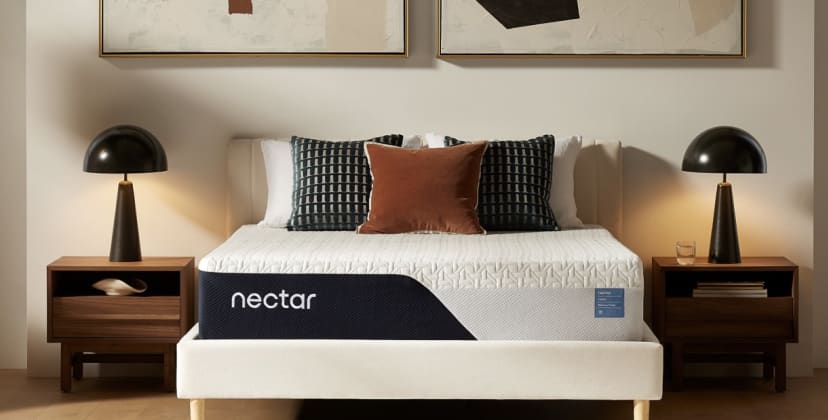
Price
$649
Mattress Type
Foam
Firmness Options
Medium Firm (6)
Trial Period
365 nights (30-night requirement)
At a Glance
- Who It’s Best For: Side sleepers who weigh less than 230 pounds, as well as back sleepers under 230 pounds.
- Feel: Inviting, with noticeable but gentle contouring around pressure points. Enough pushback to prevent feeling like you’re sinking.
- What It’s Made Of: Top layer of gel-infused memory foam, a second foam layer of responsive polyfoam, and the base is thick, high-density polyfoam.
- What We Don’t Like: Too soft for sleepers over 230 pounds, especially back or stomach sleepers.
Scoring & Reviews
The following ratings show how suitable this mattress is for different sleeping positions and sleeper weights. These scores are determined by how well the mattress supports and relieves pressure for each sleeper type.
We performed a meta-analysis on 10000 validated customer reviews of the Nectar Mattress. This is what people who bought the mattress had to say:- Pain Relief: Many users have reported significant relief from back, neck, and joint pain. The mattress seems particularly beneficial for those with chronic pain, contributing to better overall sleep quality.
- Free Accessories: Nectar often includes free pillows, mattress protectors, and sheets with the mattress, adding value and convenience for new customers.
- Suitable for All Weights: The mattress supports a wide range of body weights and sizes without losing comfort or stability, making it versatile for different users.
- Temperature Regulation: Several reviews indicate that the mattress does a good job of staying cool throughout the night, which is a significant benefit for those who tend to sleep hot.
- Customer Service: Positive remarks about Nectar’s customer service are common, with many customers feeling supported during the purchasing and setup process.
- Durability Concerns: While many users find the mattress supportive and comfortable, there are occasional mentions of durability concerns, such as sagging or indentations developing over time, particularly from heavier users.
Best Under $500
Brooklyn Bedding CopperFlex Memory Foam
8.6 /10
Test Lab Score
30% off sitewide
30% off sitewide
Priced well below average for a memory foam mattress of this caliber, the Brooklyn Bedding CopperFlex represents exceptional long-term value for shoppers with limited budgets. Plush comfort layers, zoned transitional foam, and a sturdy base help ensure a balanced sleep experience for most side and back sleepers.

Credit: Sleep Foundation Test Lab
Price
$466
Mattress Type
Foam
Firmness Options
Medium Firm (6)
Trial Period
120 nights (30-night requirement)
At a Glance
- Who It’s Best For: Side sleepers who weigh at least 130 pounds and back sleepers up to 230 pounds, as well as couples and hot sleepers.
- Feel: Medium firm (6). Plush and adaptive with extra pushback around your torso and hips.
- What It’s Made Of: Thin layer of adaptive polyfoam sewn to the cover, followed by two memory foam layers infused with copper fibers. Support system is three-zone transitional foam and two layers of high-density polyfoam. The cover is cooling GlacioTex fabric.
- What We Don’t Like: Initial odor for up to 72 hours after unboxing. Too soft for most stomach sleepers over 130 pounds.
Scoring Breakdown
The following ratings show how suitable this mattress is for different sleeping positions and sleeper weights. These scores are determined by how well the mattress supports and relieves pressure for each sleeper type.
We performed a meta-analysis on 549 validated customer reviews of the Brooklyn Bedding CopperFlex Memory Foam. This is what people who bought the mattress had to say:- Pricing and Value: Many reviewers have highlighted that the mattress is affordable and offers great value for the price, making it an excellent choice for budget-conscious shoppers.
- Heat Regulation: Several users noted that the mattress does not retain much heat, which contributes to a cooler and more comfortable sleep, especially for those who tend to sleep hot.
- Edge Support: The mattress is reported to have good edge support, which is beneficial for those who use the edge of the bed frequently or sleep close to the sides.
- Odor and Off-Gassing: Some reviews mention that the mattress has minimal off-gassing odor upon unpacking, which is a common concern with new mattresses. The smell will dissipate in a few days.
- Hybrid Option: The availability of hybrid models is appreciated, particularly for those needing more support, such as individuals with larger frames.
- Customer Service: Positive remarks about customer service suggest that the company handles queries and issues effectively.
Best for Back Pain
Nolah Original 10
8.0 /10
Test Lab Score
35% off sitewide + extra $100 off with code: SF100
35% off sitewide + extra $100 off with code: SF100
Our selection for the best mattress for back pain under $1,000 is the Nolah Original 10. The proprietary foams in the top of this mattress give dynamic support to the heavier parts of the body, alleviating pressure and enabling a healthier spinal alignment that can help minimize back pain.
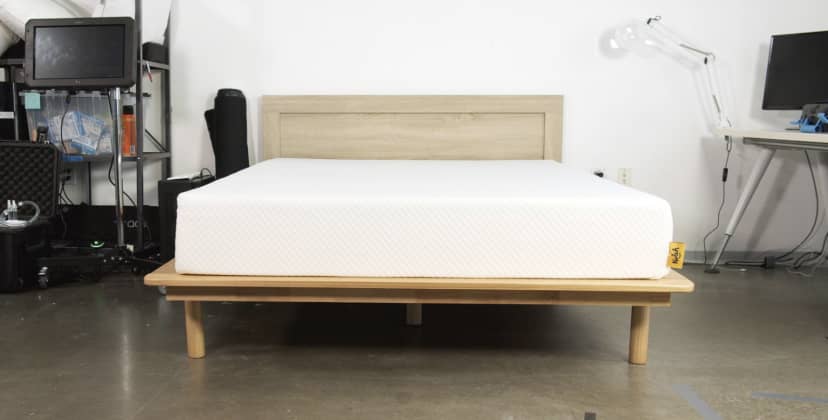
Credit: Sleep Foundation Test Lab
Price
$942
Mattress Type
Foam
Firmness Options
Medium (5)
Trial Period
120 nights (30-night requirement)
At a Glance
- Who It’s Best For: Side sleepers under 230 pounds, particularly those under 130 pounds. Also good for couples.
- Feel: Medium (5). Cradling around lower back, hips, and shoulders but won’t cause you to feel like you’re being enveloped.
- What It’s Made Of: Top two layers are proprietary copper-infused AirFoam. The base is a thick layer of sturdy polyfoam.
- What We Don’t Like: Too plush for most sleepers over 230 pounds. Return fee of $99.
Scoring & Reviews
The following ratings show how suitable this mattress is for different sleeping positions and sleeper weights. These scores are determined by how well the mattress supports and relieves pressure for each sleeper type.
Best for Side Sleepers
Bear Original
7.8 /10
Test Lab Score
40% sitewide with code: SF40
40% sitewide with code: SF40
For side sleepers who need a mattress that can cushion their hips and shoulders, there’s no better option under $1,000 than the Bear Original Mattress. Using gel-infused memory foam, this mattress softens impact around key pressure points, letting you settle into a side sleeping posture while maintaining proper spinal alignment.
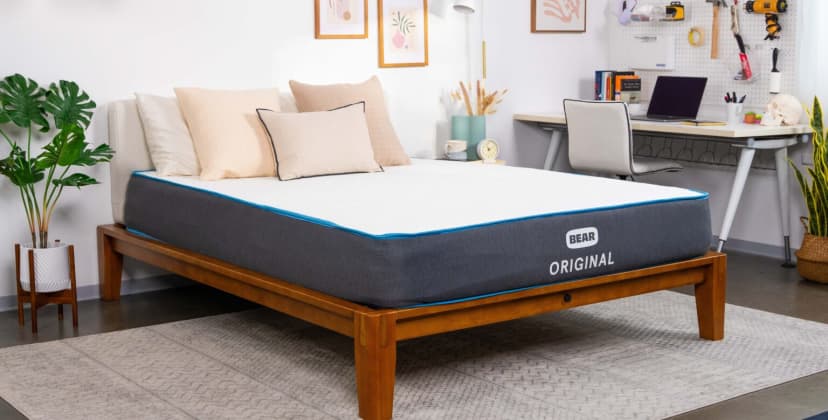



Credit: Sleep Foundation Test Lab
Price
$649
Mattress Type
Foam
Firmness Options
Firm (7)
Trial Period
120 nights (30-night break-in period)
At a Glance
- Who It’s Best For: Side sleepers between 130 and 230 pounds, back sleepers who weigh less than 230 pounds, and stomach sleepers weighing under 130 pounds.
- Feel: Firm (7), with gentle cradling. Couples feel only minimal motion transfer.
- What It’s Made Of: Top layer is gel-infused memory foam. The second layer is a responsive polyfoam, and the bottom layer is dense polyfoam. There’s an optional cooling Celliant cover.
- What We Don’t Like: Odor after unboxing, lasting up to a few days.
Scoring & Reviews
The following ratings show how suitable this mattress is for different sleeping positions and sleeper weights. These scores are determined by how well the mattress supports and relieves pressure for each sleeper type.
We performed a meta-analysis on 10000 validated customer reviews of the Bear Original. This is what people who bought the mattress had to say:- Firmness and Comfort: Many reviewers find the Bear Original mattress to be on the firm side but still comfortable, providing a good balance of support and cushioning.
- Pain Relief and Support: Users frequently report relief from back and neck pain. The mattress offers good support, which contributes to a more restful sleep and helps with physical recovery, especially noted by athletes and those with physically demanding lifestyles.
- Adjustment Period: Some customers noted a need for an adjustment period where initially the mattress felt too firm, but became more comfortable after continuous use. This is typical, and we recommend using a mattress for at least two weeks before considering a return.
- Temperature Regulation: There are some mixed reviews regarding temperature control; some users mention that the mattress does a good job at staying cool, while a few others still experience heat retention. This is most likley due to the memory foam featured in the mattress. If you’re a particularly hot sleeper, you may want to look elsewhere.
- Ease of Setup: The mattress is easy to unbox and set up, and it quickly expands to its full size. Customers appreciate the ease of installation.
- Customer Service: Bear’s customer service is frequently praised for being responsive and helpful, enhancing the overall buying and service experience.
Best Pressure Relief
Silk & Snow Hybrid
7.8 /10
Test Lab Score
$150 off at Silk & Snow
$150 off at Silk & Snow
For a great pressure-relieving mattress available for under $1,000, there’s no better option than the Silk & Snow Hybrid. It delivers a stellar combination of contouring and bounce that cushions the lower back and other pressure zones to enhance your comfort and support.
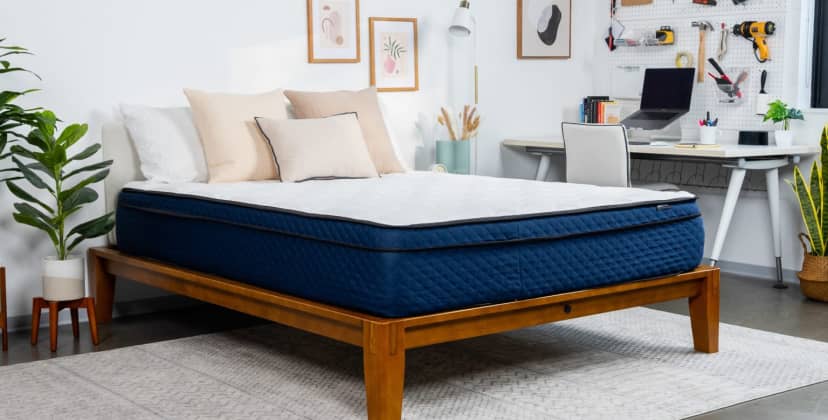
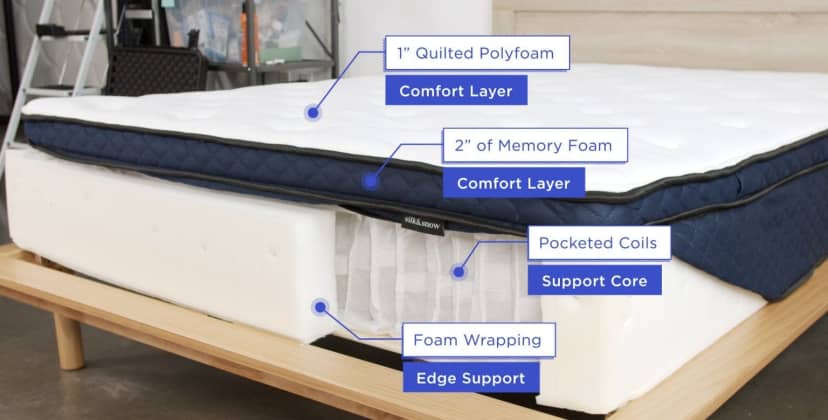
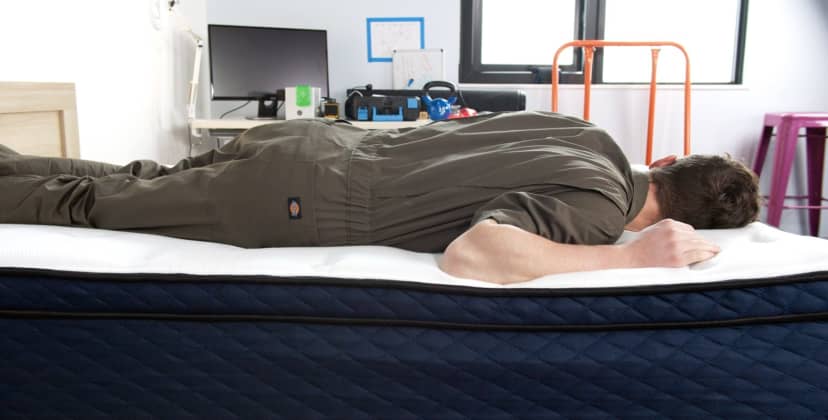
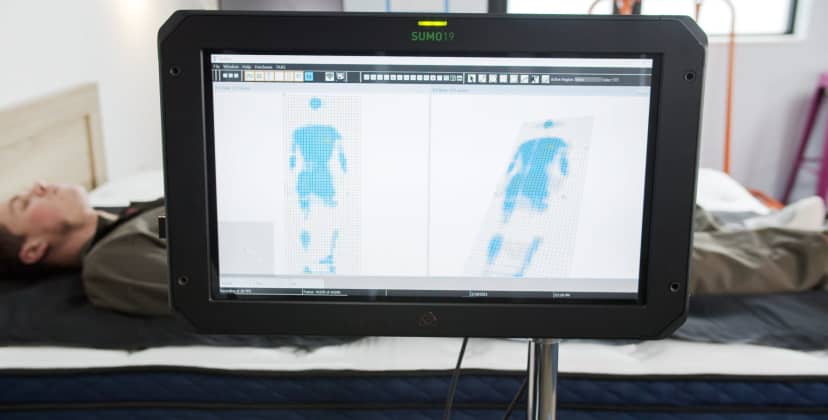
Credit: Sleep Foundation Test Lab
Price
$700
Mattress Type
Hybrid
Firmness Options
Medium Soft (4), Medium Firm (6)
Trial Period
365 nights (30-day requirement)
At a Glance
- Who It’s Best For: Side and back sleepers under 130 pounds (medium soft). Side and back sleepers over 130 pounds (medium firm).
- Feel: Medium soft (4) version conforms very closely, resulting in a deep body hug. Medium firm (6) design is more balanced with gentle contouring, light bounce, and solid edge support.
- What It’s Made Of: Top is polyfoam and breathable fiber quilted into the mattress cover. A 2-inch layer of gel-infused memory foam and a support core of pocketed steel coils that are reinforced around the edge and under the midsection.
- What We Don’t Like: Too soft and not supportive enough for most stomach sleepers over 130 pounds.
Scoring Breakdown
The following ratings show how suitable this mattress is for different sleeping positions and sleeper weights. These scores are determined by how well the mattress supports and relieves pressure for each sleeper type.
We performed a meta-analysis on 3,831 validated customer reviews of the Silk & Snow Hybrid Mattress. This is what people who bought the mattress had to say:- Balanced: Owners say this bed has the perfect blend of comfort and great support, with side sleepers in particular calling it out as ideal for their needs.
- Firmness Level: The medium-firm model is true to its label, and provides a balanced feel between support and softness.
- Temperature Regulation: Customers agree that the Hybrid has excellent temperature control and offers a cool sleep experience for people who sleep hot.
- Durability: Customers report long-term satisfaction, with some noting the mattress is as comfortable after four years of daily use as it was on the first day.
- Customer Service and Delivery: Reviews mention timely delivery and positive experiences with customer service, enhancing the overall purchasing experience.
Best for Couples
Layla Memory Foam Mattress
8.4 /10
Test Lab Score
Get an extra $10 off with exclusive code: sleepy10
Get an extra $10 off with exclusive code: sleepy10
Our pick for the best mattress for couples that you can buy for under $1,000 is the Layla Memory Foam Mattress. It has a unique reversible design, offering two-for-one firmness. On both sides, copper-infused memory foam cushions the body and contains vibrations so that bed partners aren’t disrupted by movement on the other side of the mattress.
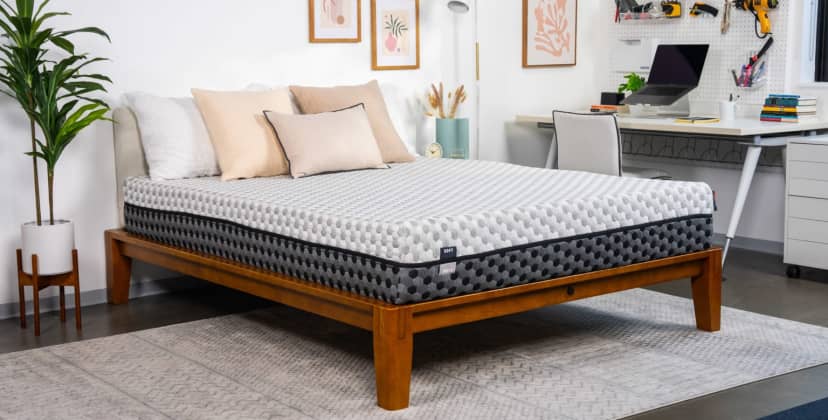
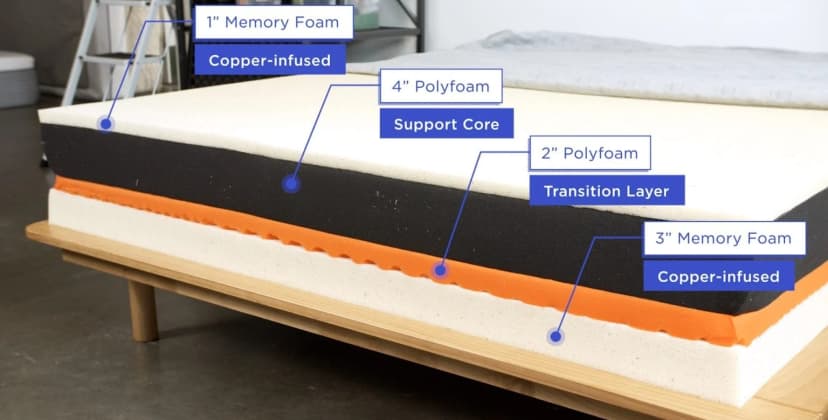

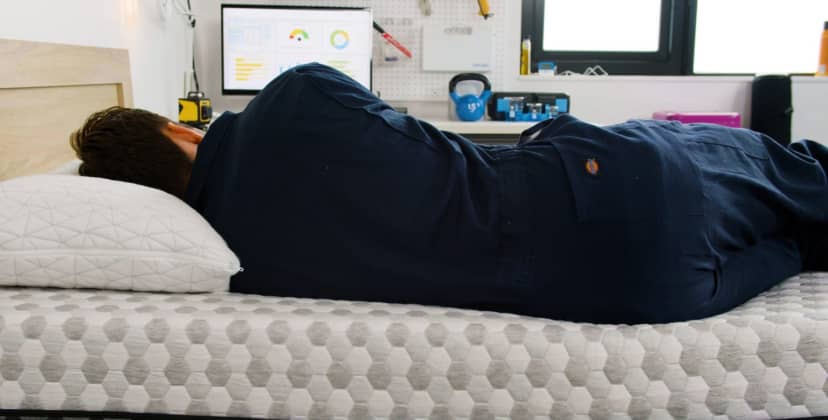
Credit: Sleep Foundation Test Lab
Price
$949
Mattress Type
Foam
Firmness Options
Medium Soft (4), Firm (7)
Trial Period
120 nights (4 week minimum)
At a Glance
- Who It’s Best For: Couples, as well as side sleepers and most back and stomach sleepers under 230 pounds.
- Feel: One side is medium soft (4) firmness, and the other is firm (7). Both sides cradle pressure points, but there’s a deeper degree of hug on the softer side.
- What It’s Made Of: Copper-infused memory foam. The soft side has a layer of resilient and adaptable polyfoam. Both sides share a core made of sturdy, high-density polyfoam.
- What We Don’t Like: Softer side may lack firmness for sleepers over 130 pounds. “New mattress smell” after unboxing.
Scoring & Reviews
The following ratings show how suitable this mattress is for different sleeping positions and sleeper weights. These scores are determined by how well the mattress supports and relieves pressure for each sleeper type.
We performed a meta-analysis on 7558 validated customer reviews of the Layla Memory Foam Mattress. This is what people who bought the mattress had to say:- Dual Firmness Options: The Layla Memory Foam Mattress offers both soft and firm sides, allowing users to choose according to their comfort preferences, which is highly appreciated for accommodating different sleeping styles.
- Comfort and Support: Many reviewers have noted the mattress provides exceptional comfort, helping alleviate back pain and improving overall sleep quality. The soft side is often described as cloud-like, while the firm side offers adequate support without being too hard.
- Quality and Durability: Users report that the mattress maintains its shape and comfort over time, with no significant sagging or indentations, even after several years of use, indicating good durability.
- Temperature Regulation: The mattress is generally reviewed as doing a good job of regulating temperature, preventing overheating during sleep, which is a common issue with many memory foam mattresses.
- Ease of Setup: Customers appreciate the ease with which the mattress can be set up. It is delivered in a box and expands quickly once unpacked, making it convenient for immediate use.
- Customer Service: Layla’s customer service receives high praise for being responsive and helpful, aiding customers with issues ranging from delivery to product inquiries and returns.
Best Cooling
Cocoon Chill
7.6 /10
Test Lab Score
35% off at Cocoon
35% off at Cocoon
For hot sleepers with a limited mattress budget, the Cocoon Chill is a leading option for more comfortable and cooler sleep. Specialty materials help dissipate heat, but even with its cooling features, the Cocoon Chill is available for under $1,000.
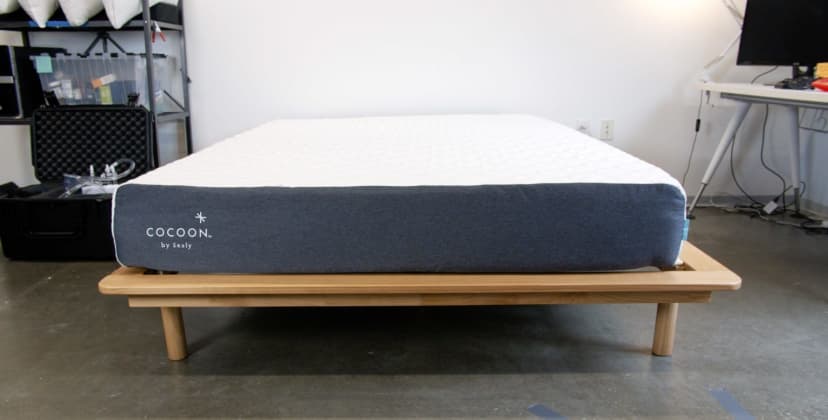



Credit: Sleep Foundation Test Lab
Price
$699
Mattress Type
Foam
Firmness Options
Medium Firm (6)
Trial Period
100 nights (30-night requirement)
At a Glance
- Who It’s Best For: Side and back sleepers between 130 and 230 pounds, as well as hot sleepers.
- Feel: Medium firm (6) with moderate contouring that helps cushion high-pressure areas like the hips, lower back, and shoulders. Doesn’t have excess sinkage and doesn’t retain heat.
- What It’s Made Of: A cover with a temperature-regulating phase change material and a breathable memory foam. The middle layer is dynamic polyfoam, and the base is 6 inches of dense and durable polyfoam.
- What We Don’t Like: Weaker around the edge of the mattress. Not enough midsection support for stomach sleepers over 130 pounds.
Scoring Breakdown
The following ratings show how suitable this mattress is for different sleeping positions and sleeper weights. These scores are determined by how well the mattress supports and relieves pressure for each sleeper type.
Best for Kids
Helix Kids
8.3 /10
Test Lab Score
25% off sitewide
25% off sitewide
The best mattress with a price tag under $1,000 to give children the comfort and support they need is the Helix Kids Mattress. With its reversible design, the firmness level can be easily adjusted when kids start to grow and have different support needs.
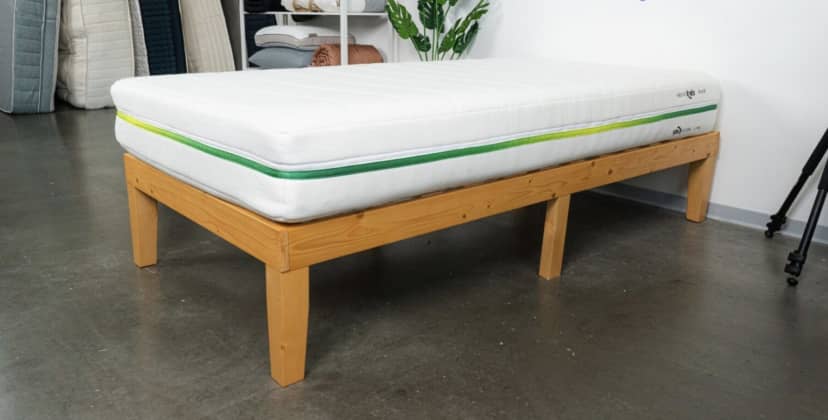
Credit: Sleep Foundation Test Lab
Price
$749
Mattress Type
Hybrid
Firmness Options
Medium Soft (4), Medium Firm (6)
Trial Period
120 nights (30-night requirement)
At a Glance
- Who It’s Best For: Children between 3 and 13. Kids under 7 usually prefer the medium firm (6) side, while those over 8 tend to get better support from the medium soft (4) side.
- Feel: Light cushioning and considerable bounce. Kids feel comfortable and supported while allowing them to move around easily on the mattress.
- What It’s Made Of: The core is springy pocketed coils that have a reinforced edge. The softer side has a layer of gel-infused memory foam, and the firmer side features a responsive and resilient polyfoam. The cover is Tencel material.
- What We Don’t Like: May lack support for kids who are over 13. If only one side of is used, it may affect durability.
Scoring & Reviews
The following ratings show how suitable this mattress is for different sleeping positions and sleeper weights. These scores are determined by how well the mattress supports and relieves pressure for each sleeper type.
We performed a meta-analysis on 514 validated customer reviews of the Helix Kids. This is what people who bought the mattress had to say:- Versatility: The mattress is flippable with different firmness levels, making it suitable for children as they grow. This feature is highly valued by parents looking to make a long-term investment in a mattress.
- Material Quality: Users generally report that the mattress is made from high-quality materials, contributing to its durability and comfort.
- Smell and Off-gassing: Some users report a noticeable smell upon unpackaging, which can take a few days to dissipate. This is a common issue with new mattresses but can be a concern for sensitive individuals.
- Size Issues: There are occasional complaints about the mattress not fitting perfectly in standard frames, sometimes being slightly shorter or narrower than expected.
- Customer Service: Helix generally receives positive reviews for customer service, with prompt and helpful responses. However, there are isolated reports of delivery issues or difficulty arranging returns.
The Best Deals of the Week
-
Save $166
—
Brooklyn Bedding CopperFlex Memory Foam
$499 (List Price $665) -
Save $480
—
Helix Midnight Luxe
$1,919 (List Price $2,399) -
Save $2,436
—
Nectar Adjustable Bundle
$1,398 (List Price $3,834) -
Save $771
—
WinkBed
$1,799 (List Price $2,570) -
Save $1,020
—
DreamCloud Classic Hybrid
$699 (List Price $1,719)
Best Overall
Nectar Classic
8.3 /10
Test Lab Score
Save up to 50% on mattresses + 15% off regular prices
Shop NowAn all-foam mattress for under $1,000 that offers excellent comfort and pressure relief.
See More Details
Best Under $500
Brooklyn Bedding CopperFlex Memory Foam
8.6 /10
Test Lab Score
30% off sitewide
Shop NowImpressive cooling and motion isolation from an affordable memory foam mattress.
See More Details

Credit: Sleep Foundation Test Lab
Best for Back Pain
Nolah Original 10
8.0 /10
Test Lab Score
35% off sitewide + extra $100 off with code: SF100
Shop NowA mattress with a competitive price-point that offers first-rate back support and pain relief.
See More Details

Credit: Sleep Foundation Test Lab
Best for Side Sleepers
Bear Original
7.8 /10
Test Lab Score
40% sitewide with code: SF40
Shop NowAn ideal combination of affordability and comfort in a dependable all-foam mattress.
See More Details
Best Pressure Relief
Silk & Snow Hybrid
7.8 /10
Test Lab Score
$150 off at Silk & Snow
Shop NowA supportive hybrid that relieves pressure with a zoned design that amps up spinal support.
See More Details
Best for Couples
Layla Memory Foam Mattress
8.4 /10
Test Lab Score
Get an extra $10 off with exclusive code: sleepy10
Shop NowA mattress with a reversible design, wallet-friendly price, and above-average motion isolation.
See More Details
Best Cooling
Cocoon Chill
7.6 /10
Test Lab Score
35% off at Cocoon
Shop NowAn affordably priced memory foam mattress with innovative cooling features.
See More Details
Best for Kids
Helix Kids
8.3 /10
Test Lab Score
25% off sitewide
Shop NowA budget-friendly and reversible mattress that gives your child two firmness levels to choose from.
See More Details
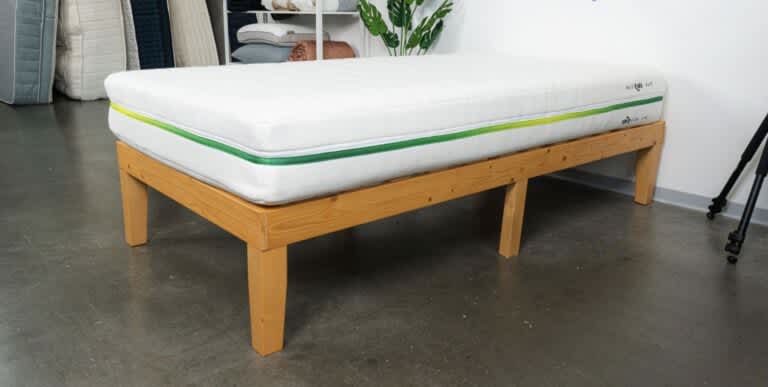
Credit: Sleep Foundation Test Lab
Watch Video: We Tested the Best Mattresses Under $1,000 – Here Are Our Favorites
Our sleep experts offer an in-depth look at some of our top mattress picks under $1,000. Watch the video below to see how each mattress performed when put to the test in our lab.
How to Choose the Best Mattress Under $1,000
Just because you’re working with a limited budget doesn’t mean you have to settle for a low-quality mattress. While a higher spending limit can open up more options, plenty of great mattresses are available for under $1,000.
When shopping for an affordable mattress, there are several details to consider. If you want to find the best possible deal, weighing these factors can help you find the most cost-effective option for your needs and preferences.
What to Look for in a Mattress
When shopping for a mattress, you’ll probably come across an abundance of mattress terminology and marketing promotions. While it’s easy to be drawn in, you’re most likely to be happy with your purchase if you focus on the nuts-and-bolts of the mattress.
These factors are the most essential to look for, and thinking about which matter the most to you lets you shrink your options and clarify which brand and model is the best match for you.
Price
You don’t need to spend a lot of money to find something that will suit your needs. Many budget models perform well in key areas regardless of their cost. More importantly than price, however, shoppers should consider value. An inexpensive mattress may ultimately cost the consumer more if it needs to be replaced sooner due to quality issues. At the same time, a more expensive mattress could be a better value if it has a long lifespan and an enhanced performance.
Sleeping Position
Sleeping position is essential to consider when you shop for a mattress. It may be especially critical for budget shoppers, since they may not have the extra funds to modify their surface with a topper or other accessories if the mattress isn’t ideal. If you’re a side sleeper, you should generally look for a model that is highly rated for pressure relief. Back and stomach sleepers typically need a firmer model with enough support to promote proper spinal alignment.
Quality Materials
Although shopping within a budget might make it difficult to get a mattress with certain features, you should still be able to find a model with high-quality components. Selecting the best quality possible can improve the bed’s life expectancy.
Firmness Level
The firmness level can often impact how well a mattress performs for certain body types and sleep positions. Generally, most sleepers prefer a medium or medium firm mattress. However, individuals who weigh less than 130 pounds may favor a softer model, especially if they sleep on their sides. Those who weigh more than 230 pounds may need a firmer option for extra support, particularly if they sleep on their backs or stomachs.
Pressure Relief
If you need relief for pressure points, such as your shoulders or hips, consider a mattress with memory foam, polyfoam, latex, or other materials that contour to the body to redistribute its weight. While certain types of innerspring coils can also provide pressure relief, mattresses with substantial foam layers usually perform best in this area.
Motion Isolation
Light sleepers sometimes wake up at the slightest hint of movement from their partners. A mattress with strong motion isolation absorbs these vibrations to reduce sleep disruptions. Memory foam and polyfoam models tend to perform noticeably well in this area, but other materials can also limit motion transfer.
Temperature Regulation
If you tend to get uncomfortably warm in bed, you may prefer a mattress with strong temperature regulation. Breathable materials allow heat to escape, but other components, like phase change materials and special infusions, are designed specifically for cooling.
Edge Support
One of the most common problems with low-cost mattresses is sagging. A sturdy edge can enhance the structural integrity of the bed and allow you to use the full surface of the mattress. Models with coil cores usually earn the highest marks in this category, but firmer all-foam models can also perform well.
Contouring
Contouring refers to how well the materials of a mattress cradle the body. When a mattress conforms to the sleeper’s shape, it spreads out their weight to relieve pressure and support the spine. Contouring can be especially important for side sleepers since their hips and shoulders typically press harder against the sleep surface.
Mattress Type
The most common types of mattresses include innerspring, hybrid, all-foam, and latex. Innerspring and all-foam models are usually most affordable, but all mattress types have potential benefits that may make them ideal for some sleepers.
Mattress Types
There are a few different styles of mattresses on the market today, and each has slight variations that make it distinct. While there are some commonalities between mattresses of the same type, each model is unique, so performance may vary.
Hybrid
A hybrid model combines elements from two or more other mattress types. Coils typically make up the support core, while the comfort system usually uses polyfoam, memory foam, and/or latex. This combination of materials typically results in a mattress that rates well in many different categories.
Hybrid models are often more expensive than other mattress types, but budget-friendly options are also available.
Innerspring
Innerspring mattresses have been popular for over a century, and they are often very cost-effective. While coils are usually the main component, many modern models also include additional thin layers of polyfoam or memory foam for cushioning.
While innerspring models usually excel in responsiveness, temperature regulation, and edge support, they may not provide the motion isolation and pressure relief some sleepers prefer. However, some budget shoppers may choose to buy an innerspring mattress and a topper to create a hybrid-like feel.
Foam
As the name implies, an all-foam mattress uses memory foam, polyfoam, or a combination of both. The comfort and transition layers may use memory foam or polyfoam, while the core generally consists of high-density polyfoam. Budget models often rely more heavily on polyfoam, which tends to be more breathable and responsive than memory foam. However, it also doesn’t hug as closely to the body and low-density varieties may be less durable. Some foam models also add layers of latex, but these are typically less common and more expensive.
An all-foam mattress can be particularly suitable for side sleepers who experience pain from pressure points, as the materials cradle the shape of the body to spread out its weight.
Latex
Latex mattresses may use natural, synthetic, or blended latex. Natural latex models are the most common, and they’re usually more expensive than other models due to the cost of this material. The advantage of latex is that it relieves pressure while also pushing back against the sleeper’s body, which means sleepers shouldn’t sink too far into the mattress. Some sleepers compare this to a floating sensation.
Natural latex also tends to be more environmentally friendly than most synthetic foam, making it a popular choice with eco-conscious shoppers.
While the higher price-point of a high-quality latex model may not appeal to some budget shoppers, the durability of the material may make it a good investment.
What Can Affect the Price of a Mattress?
Multiple factors can impact the cost of a mattress. When you’re working with a limited budget, it is important to consider these details to find the best option for your money.
Quality and Type of Materials: Price depends partially on the type of materials used in a mattress’ construction. For instance, memory foam and natural latex often cost more. Coils and polyfoam tend to be much more cost-effective, and high-quality options can be highly durable. However, low-quality polyfoam and coils may prematurely sag or show other signs of wear.
Durability: The less durable your mattress, the more likely it will be to develop issues like sagging that limit its usable lifespan. Durability is usually linked to the quality of the materials, so shoppers who want their mattress to last may prefer to select the highest quality model that accommodates their needs, preferences, and budget.
Mattress Layers: Mattresses with more layers are typically thicker and pricier due to their extra materials and more complicated constructions. While their additional layers may improve the performance of some models, shoppers can often save money by selecting an option with a simpler design.
Density: The density of foam affects its performance and durability. Lower-density polyfoam and memory foam typically cost less, trap less heat, and respond more quickly to changes in pressure. However, they also tend to be less durable and not as exceptional at pressure relief and motion isolation.
Proprietary Technology: Some mattresses use proprietary materials, and this almost always results in a higher price due to costs associated with development. Some special components can improve the performance of a mattress, however, so they may be worth the extra expense for some shoppers.
Shipping Rates, Returns, and Warranties
Shipping, return, and warranty policies can differ quite a bit from one mattress manufacturer to the next. When you add retail stores into the mix, these details could get even more confusing.
Shipping
While there are differences between how each mattress manufacturer or retailer will ship their products, most of them take a very similar approach. With that being said, a few variances can impact when and how you receive your new mattress.
How Long Will It Take to Arrive?
Many companies assemble the mattress upon receiving an order, and this process can take a few days, adding to the shipping time. Once sent, shipments originating from your region may take just a couple of days to arrive, but those coming from across the country can take a week or more.
How Is It Shipped?
Most manufacturers work with a shipping company to send your mattress to your front door. Mattress-in-a-box models are typically compressed, wrapped in plastic, and encased in a box. Some companies also offer White Glove delivery, which means they will send a team to deliver and set up the new mattress. Old mattress removal may also be included. This service usually costs extra, but a few companies include it at no charge.
Is Shipping Free?
Many mattress manufacturers and retail mattress chains offer free shipping. Most of these services include to-the-door-delivery. However, a few companies include White Glove delivery at no additional cost.
Returns
If you’re shopping on a budget, a good return policy may be especially useful to ensure you have recourse if the mattress isn’t ideal for you. Most online mattress sellers include a trial period to give you a chance to adjust to the bed before you make an official decision. These policies typically last between 90 days and a year.
How Are Returns Handled?
Three return methods are most common. Many companies ask you to donate your unwanted mattress to an eligible local charity and send them proof of the donation. Some will also help arrange for the charity to pick up the mattress. Other companies send a team to remove the mattress from your home. A few manufacturers may ask you to send the mattress back to them, though this is not standard due to the difficulty of packing a mattress for shipment.
Are Returns Free?
Although many companies offer free returns, some may require you to pay transportation and/or service fees.
Warranties
Mattress manufacturers usually offer a warranty to protect against eligible defects in manufacturing and materials. The terms of mattress warranties can vary quite a bit, so reading them carefully can give you a clearer idea of the level of coverage.
What Does a Warranty Cover?
Mattress warranties typically cover specific defects in the materials or manufacturing, like splitting foam and indentations greater than a certain depth. Changes in personal preferences and damage from mishandling, abuse, and accidents are not covered.
What Should You Look for in a Warranty?
The main detail to look for is warranty length. While some companies offer a 5- to 10-year warranty, others provide warranties that last 20 to 25 years. The terms can also be important, as they will define how returns work and how they deem a mattress to be defective.
How Much Does a Warranty Cost?
Typically, mattress manufacturers offer warranties at no additional cost. However, the mattress owner may be expected to pay associated transportation and/or handling charges should they make a warranty claim. Some policies also include a prorated fee structure for repairs and replacements based on how long you’ve owned the mattress.
Additional Mattress Costs
When purchasing a new mattress, it may be necessary to consider related costs. These expenses could easily add up and become an issue for shoppers with a limited budget. Whether you choose to limit extra expenses or set aside money for them, you should be aware of additional costs you may incur and how they can impact your experience and budget.
Bed Frames and Bedding: If you purchase a different mattress size than what you previously owned, you’ll likely need a new frame and bedding to accommodate it. Similarly, high-profile mattresses require deep pocket sheets, so you may need a new set if you select a thicker model. High-quality mattress covers, protectors, and sheets can also improve the lifespan of a bed, so they may be worth the expense to protect your investment.
Shoppers should keep in mind that many mattress warranties require that a reliable foundation support the mattress. Before purchasing a new frame or using your existing foundation, read through the terms of the warranty to ensure you don’t inadvertently void the policy.
Mattress Removal: Old mattresses must be disposed of appropriately, which may be an extra expense. These services are sometimes provided by mattress companies and retail stores for an additional fee, though a few include it at no additional cost. If old mattress removal is not available, you’ll need to look into local regulations to ensure you discard it correctly. Recycling is usually the best way to dispose of a mattress that’s no longer usable.
Expert Assembly: Boxed mattresses typically come with unpacking instructions. While most new owners find it relatively simple to set up their new bed, expert help can come in handy if you’re unsure, have physical limitations that make moving large objects difficult, and/or can’t enlist a friend or family member to assist you. White Glove delivery includes unpacking, assembly, and setup. This service often carries an additional fee, though a few companies include it in the purchase price.
How to Get the Best Deal on a Mattress
A new mattress can be expensive, but useful strategies can help you save money. These methods could easily cut your costs by hundreds of dollars, which might allow you to consider a bigger mattress, new bedding, or other related accessories to complete your bedroom setup.
Shop During Mattress Sales
Both retailers and mattress manufacturers often have sales during holidays or special sale events, such as Black Friday. These sales are typically offered at least once every few months, so you might want to check prices around the next holiday to see what deals are available.
Buy Online
Customers can often save money by buying a mattress directly from the manufacturer’s website. This can eliminate some of the usual overhead costs that get passed on to consumers, like the operating expenses associated with brick-and-mortar retail locations. Additionally, while some mattress and furniture stores charge for delivery, most direct-to-consumer mattress companies ship for free.
As an added bonus, buying online allows you to comparison shop and carefully weigh your options without pressure from salespeople, which may make it easier to find the best value for your money.
Coupon Codes, Referrals, and Discounts
Mattress companies frequently offer savings through coupon codes, referrals, and other discounts. While these deals are often displayed on the product page, you might also receive offers if you sign up for emails from the company.
Comparison Shop
Comparing prices between different mattress types, brands, and models can give you a better idea of what is available within your budget. Once you think you’ve found the right bed for you, you might continue comparison shopping to determine whether you can get a better price through the company’s website or a third-party vendor. Note that shipping and delivery policies may vary between sellers, so it’s important to pay attention to the fine print.
How We Test: Your Comfort Is Our Science
Our industry-leading product testing team cares deeply about improving your sleep. Having a holistic understanding of a mattress’s role as part of a sleep system is paramount to our testing process. Since a bed’s comfort and feel depend largely on body weight and sleeping position, our testing team represents a wide range of body types, sleep positions, and comfort preferences.
In our Seattle-based Test Lab, we use an objective, hands-on process to evaluate mattresses across performance categories. The following are the key guidelines that inform our performance ratings. Our ultimate goal is to ensure you have all the information you need to make the best purchase decision for you.
Construction analysis: Mattress construction plays a major role in our ratings system. We begin our testing with a top-to-bottom analysis of each mattress, making note of its materials, firmness, thickness, and other physical attributes. Price-point is another major factor as we assess quality of materials and overall value.
Quantitative product testing: For hands-on testing, our team members take turns lying and moving on each mattress. This immersive process helps us evaluate beds for performance categories like motion isolation, pressure relief, ease of movement, and temperature control.
Field testing: Once we’re finished testing a mattress in our lab, one of our team members takes it home and sleeps on it in their own bedroom for two to three weeks. Field testing helps us understand how each mattress performs in the long term.
User feedback: In addition to our team’s testing data, we draw from customer surveys and product reviews to calculate our final ratings. This helps us ensure our findings are consistent with real-world experiences.
How We Determine Our Overall Scores


To determine a mattress’s overall score, we assign weighted percentages to performance categories based on how important they are to the individual sleep experience. For instance, areas like pressure relief and temperature control tend to matter more to people than something like off-gassing, and because more people sleep on their side and back than on their stomach, we weigh those positions more heavily
Performance Categories
Motion Isolation
This criteria alludes to the amount of motion a mattress absorbs when a sleeper moves on the surface. We use two testers lying side by side to evaluate motion isolation, who each feel for transfer while the other person moves on the mattress.
Temperature Control
To determine how well a mattress regulates temperature, we perform temperature tests and look closely at its materials and construction. Many mattresses are designed with cooling components meant to reduce heat retention.
Pressure Relief
A bed with strong pressure relief excels at preventing pressure from building up in areas like the shoulders and hips. Beds with even contouring and weight distribution are top performers when it comes to pressure relief.
Off-Gassing
A mattress in a box may release unpleasant chemical odors for a short period after you’ve unboxed it. The initial smell may be strong but typically fades within 2 or 3 days.
Ease of Movement
This criteria reflects how easily a sleeper can move across a bed’s surface. Responsive surfaces made of latex typically perform better than foam surfaces, which can inhibit movement.
Edge Support
We perform sit tests along a bed’s perimeter to measure how well the edges push back against weight. Mattresses with strong edge support have minimal sagging when sleepers sit on or lie close to the perimeter.
Dive Deeper – Mattress Guides by Price
If you want to expand your search for a new bed beyond mattresses under $1,000, take a look at our recommendations categorized by mattress price.

Still have questions?
Our product experts have extensive experience testing just about every sleep product on the market.
Send an email to AskAnExpert@sleepfoundation.org with your questions and we’ll help you find exactly what you’re looking for.
